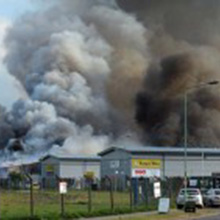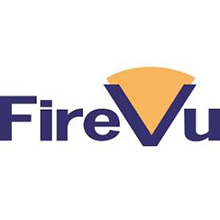 |
| Manufacturing environments have high risk processes making the threat of major fires a constant possibility |
Manufacturing plants’ vulnerability to fire ensures that safety, detection and preventive measures should never be compromised. Yet, fires still occur with alarming regularity and often terrible outcomes. Process Industry Informer takes a closer look at manufacturing fire risk and what can be done to reduce it.
Manufacturing environments possess inherently high risk processes making the threat of major fires a constant possibility. Fire prevention measures, as outlined by the Health and Safety Executive, reduce risks. Early fire detection can present special challenges, but the results of not addressing early stage fire situations quickly and adequately have serious repercussions. Questions are still being asked in Parliament after one particular fire in 2010 cost the local community 150 jobs and caused extensive environmental damage.
Simon Jenkins, product manager of FireVu, has long been acutely aware of the dangers posed by manufacturing processes discusses the issues and possible solutions with special reference to the food processing industry.
Jilin Baoyuanfeng Poultry Plant in Dehui in north east China was held up as the very model of economic progress by local officials up until June last year. Its lack of health and safety procedures led to a gruesome event that unnerved the Beijing Government when a catastrophic fire engulfed the plant and led to a horrific 120 fatalities. An ammonia leak was cited as a possible cause.
While we might expect countries striving for economic growth at the expense of safety procedures to experience such catastrophes as awful as that seems, such examples are far from confined to less developed countries.
A food processing plant in Nebraska just a few weeks ago, in January, suffered two fatalities and many injuries after an explosion led to fire and debris trapping workers. The business had had 35 workplace safety law violations in the last 40 years.
Closer to home in July 2010, a fire engulfed a Suffolk based meat manufacturing facility in Lowestoft. Wessex Foods supplied meat products for 500 UK Burger King outlets – suspected chemical cannisters were to blame for the explosion.
 |
| Early fire detection needs to have robust, resilient, effective and tailored solutions for the plants they protect |
Over the course of ten days more than 100 firefighters, with two air support units, worked to control and finally extinguish the fire. More than 50 million litres of water were used.
Firefighters worked to ensure water courses were not contaminated and that local buildings, including a petrol station remained unaffected.
Suffolk Fire and Rescue Service stated the design of the building had given crews some difficulty: the insulated rooms were prone to burning.
The results were brutal for the business and local community. 150 staff lost their jobs, 700 tonnes of burnt meat had to be cleared and 350,000 tonnes of CO2 was released.
The political backlash has pushed for the implementation of mandatory fire suppression measures, the local MP claims that sprinklers could have prevented the fire in Parliament in February.
The dangers inherent in manufacture processing
The sources of danger are as diverse as the manufacturing sector, the food processing industry has its own specific danger points:
- Ovens and conveyor belts driven by motors and pumps
- Flammable hydraulic fluids, which power the ovens and conveyor belts. These often span multiple pieces of high value plants’ kit or pass between several rooms. The risk of a serious fire with the ability to spread across the entire plant is ever present.
- Dusts prone to combustion including: flour, custard powder, instant coffee, sugar, dried milk, potato powder and soup powder
- Finely sprayed oils, mixing with potable flammable solvents such as ethanol or sterilisation techniques such as high temperature drying or spraying with hydrogen peroxide solutions
- Flammable gas fuels for ovens, flammable liquids and vapours (spirit based flavourings and cooking/coating oils).
Ignition energies vary with different substances and for similar substances with differing moisture content and particle size. A low energy static discharge from a synthetic fibre jumper can trigger an ignition as can a fixed flame from a gas fired boiler.
The Dangerous Substances and Explosive Atmospheres Regulations 2002 assesses workplace dangers for fire and explosion hazard identification, and methods of prevention or mitigation. DSEAR requires all workplaces where substances that could give rise to fire or explosion are handled or stored must be fully assessed and protected. The full list can be found on the HSE website http://www.hse.gov.uk/food/dustexplosion.html.
Aspirating Smoke Detectors (ASDs) work by assessing the presence of smoke particles suspended in air that have been drawn through sample holes |
Fire detection technology
Manufacturing processes present complex and sometimes harsh environments to operate in for systems. Chemical industries for instance have their own and similar issues. Early fire detection needs to have robust, resilient, effective and tailored solutions for the plants they protect.
The following three technologies are often used for early detection of potential fire danger.
Infrared Detection
Infrared detectors (IR) are simply transducers of radiant energy, converting radiant energy in the IR into a measurable form.
Detecting IR energy emitted by objects takes away reliance on visible light and so obscured conditions should not affect its effectiveness although thick smoke is an issue as is oil and grease.
Most IR detectors are designed to ignore constant background IR radiation, which is present, focusing on the modulated part of the radiation.
When exposed to modulated non-flame IR radiation, IR detectors become more prone to false alarms.
Operator verification ensures appropriate action is taken, minimising false alarms of already under pressure fire services.
Aspirating Smoke Detectors
The consequences of manufacturing fire risk with inadequate fire prevention and detection to workers, material and the environment can lead to tragic consequences |
Aspirating Smoke Detectors (ASDs) work by assessing the presence of smoke particles suspended in air that have been drawn through sample holes in a pipe network into a detection chamber.
ASD is highly sensitive, often detecting smoke before it is visible to the human eye, which is particularly valuable in slow growth fires or where a fire develops in inaccessible or obscured locations.
However, the sensitivity to distinguish between smoke and dust in early stage fires can be compromised, the size of dust and smoke particles can be similar.
There are technological approaches to reduce nuisance alarms, but compensatory technology may impact the sensitivity of a smoke detector and early warning reliability.
Future integration of ASD with intelligent detection systems, including remote monitoring and verification will improve its effectiveness.
Video Smoke Detection
Video Smoke Detection (VSD) is a proven technology in terms of what it can deliver to reduce manufacturing fire risk.
Essentially it detects danger by looking for smoke patterns, often at points that might be particularly vulnerable to fire risk.
Rather than waiting for a signal to trigger specific sensors, VSD can offer early warnings by cameras pointing at the subject space and looking for changes in variables. Problems arising from smoke stratifying and not reaching detection equipment are eliminated. It can also survey large open sites.
If a complex has areas that could trigger alerts from signals that might resemble smoke, such as dirt from recycling plants, then such areas can be isolated. This allows safety staff to concentrate on the key danger areas.
Safety operators can work on site or remotely. With high quality video, they can determine if an alert is a real fire risk and take appropriate action. Alerts can be studied after the event to improve safety.
Reducing manufacturing fire risk conclusion
The consequences of manufacturing fire risk couple with inadequate fire prevention and detection to workers, material and the environment can lead to tragic consequences.
The DSEAR regulations in place acknowledge the dangers inherent in the manufacturing sector, give clear instructions and the hard penalties for failure to implement regulations. The early fire detection solutions are there and while the fire danger persists, as it always will, then the benefits of tackling potentially catastrophic fires before they told hold are self-evident.
Simon Jenkins is the product manager at FireVu, which offers Video Smoke Detection (VSD) fire detection solutions for manufacturing sectors. www.firevu.co.uk


















